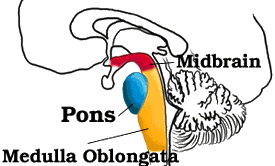Brainstem Injury – Injury to Most Basic Neural Functions
Brainstem Injury – A Core Injury to Life
Call me at 800-992-9447
A brainstem injury can occur from direct traumatic forces or as a result of increases in intracranial pressure (ICP). Shearing injury to the axonal tracts of the brainstem will cause catastropic brainstem injury.
The Medula Oblongota, at the bottom of the brainstem, contains the life maintaining controls of respiration, heart rate and blood pressure. (See the illustration at the right for the locations of the brainstem structures.) See also our page on the brainstem. A disruption of such functions ends life. Fortunately, shearing of the Medula Oblongata occurs less often than shearing in the higher areas of the brain. This is because the brainstem is closer to the center (the fulcrum) of the rotation. The closer a structure is to the center of the rotation (the neck in most cases) the less severe the shearing forces.
Brainstem injury involving shearing is also less likely because of dense and confined nature of the structures in the brainstem than the cerebral hemispheres. The cerebral cortex is a jello like structure which freely moves and shimmers. The brainstem is more fibrous and far more densely packed.
The bigger concern in the acute treatment of severe brain injury is the risk of herniation of the cerebral cortex into the brainstem area. (A herniation means the bulging of some type of organ into an area where it is not intended. For example, a hernia in the groin area is the herniation of the intestines through the wall of the abdomen.) A brainstem injury resulting from herniation will cause compressing of the brain stem and interfering with the involuntary nervous system.




